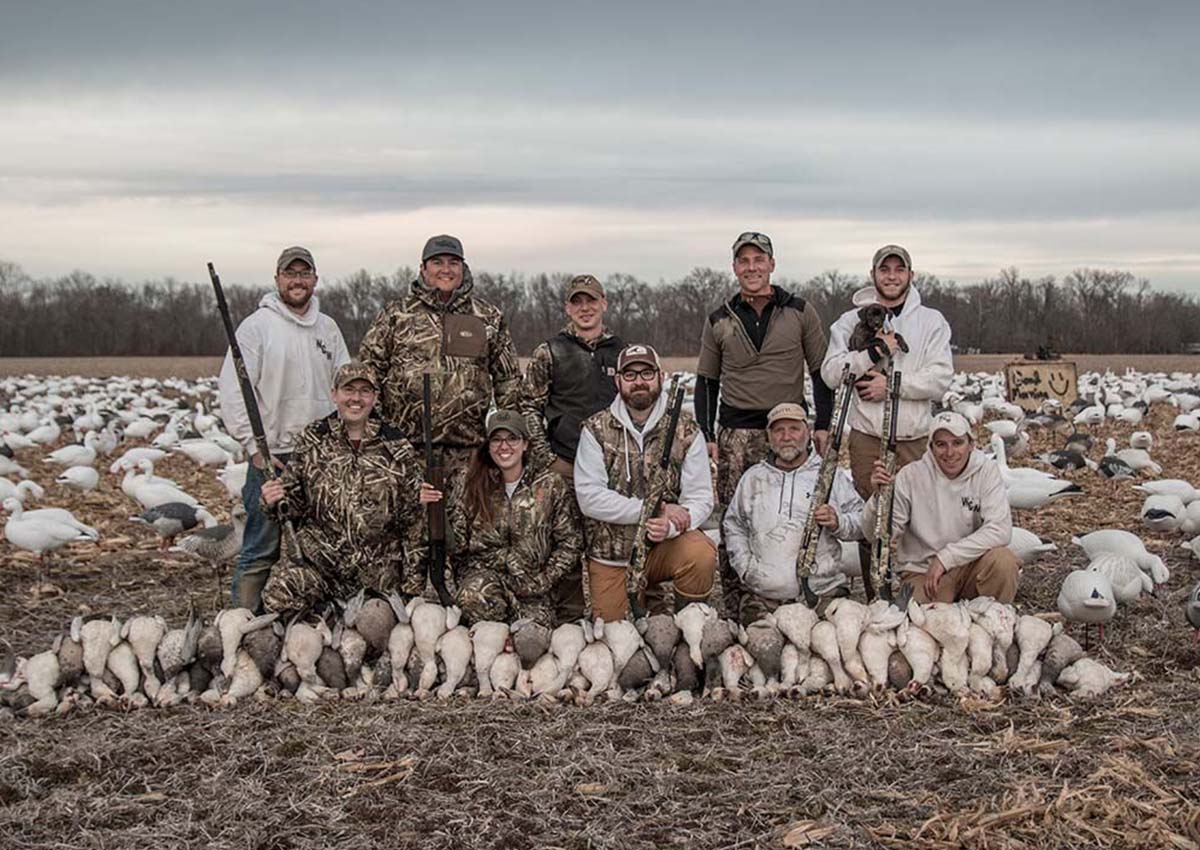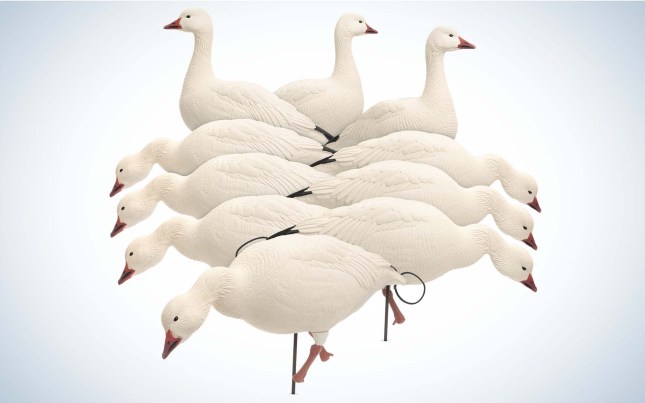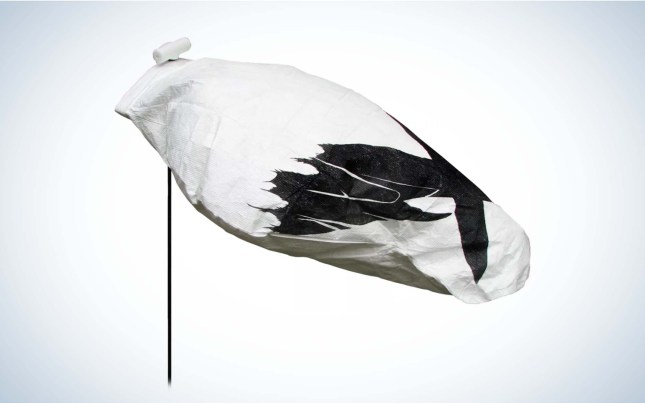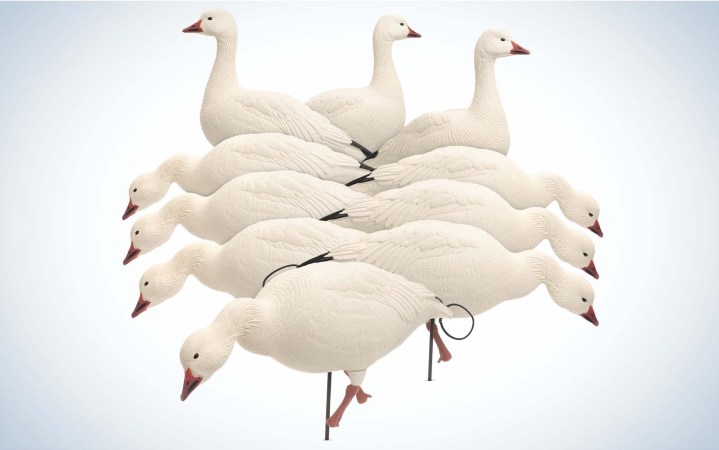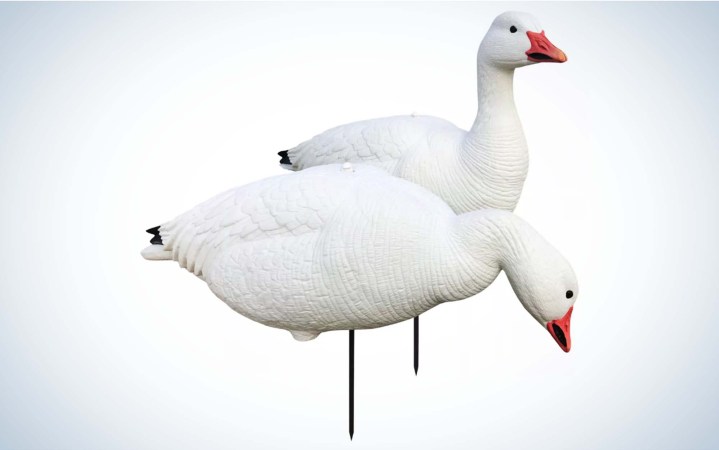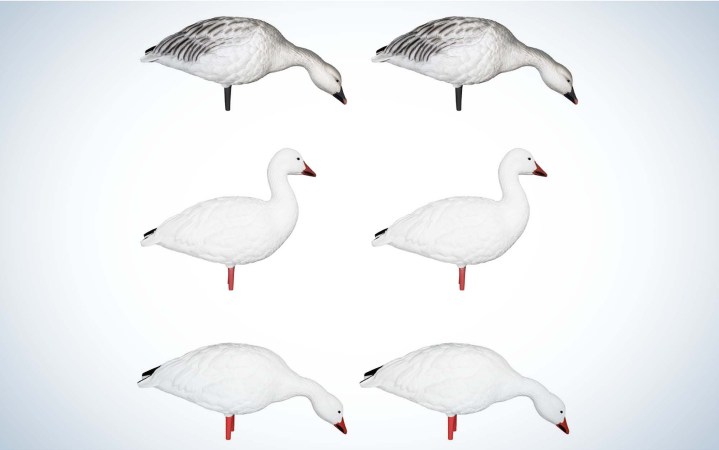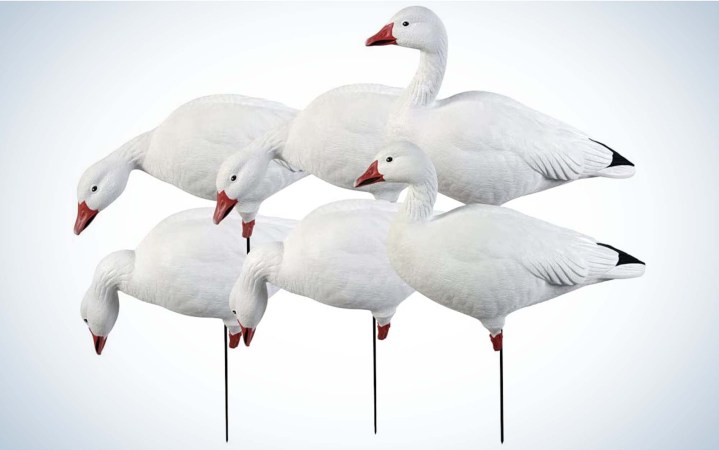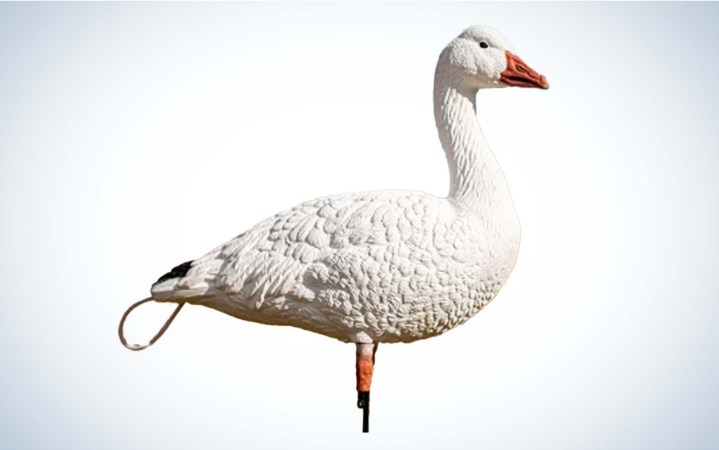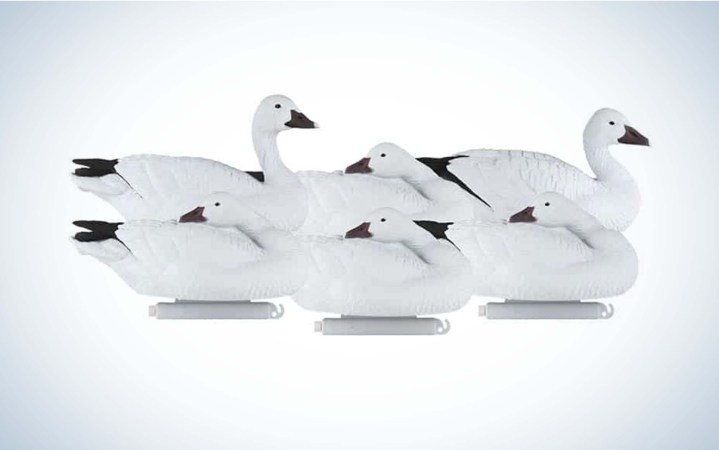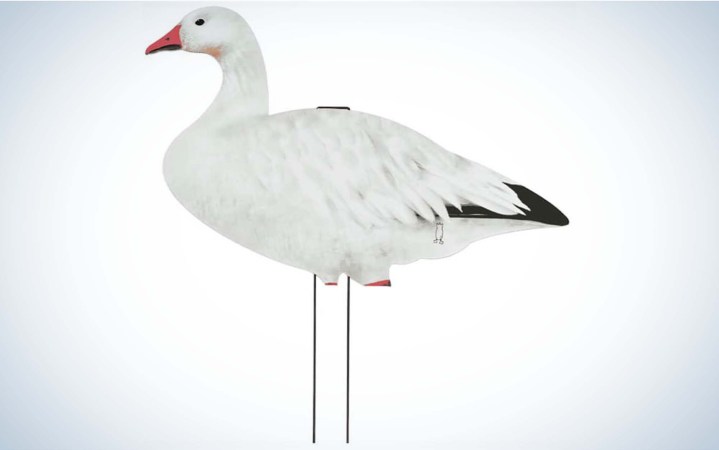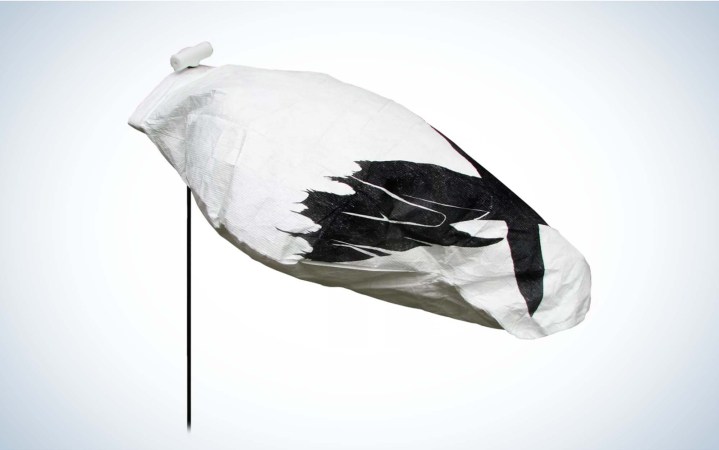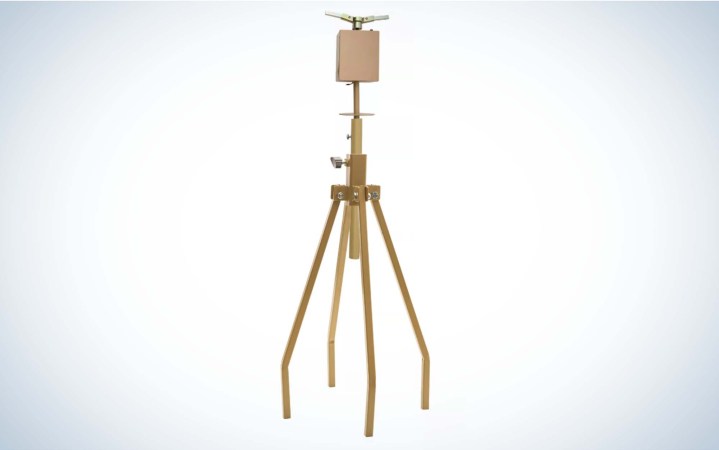We may earn revenue from the products available on this page and participate in affiliate programs. Learn More ›
Snow goose hunters that invest in thousands of decoys are some of the most passionate hunters in North America. The substantial cost of decoys is just the start. You need a trailer to haul all those full-bodies, a dependable truck to pull the trailer, an ATV to navigate muddy spring ag fields, plus the cost of gas for both vehicles, and the cases of shotshells you intend to shoot. By the time you’re watching a giant flock of snows spin into the decoys, you’ve spent damn near $100,000. And if you drop that kind of cash on hunting, you’re obsessed with it.
Because you’re making this investment, it’s important to know which decoys suit your style of hunting—and budget—best. So to help you out, here is what I’ve learned about the quality of snow goose decoys on the market. I’ve hunted over many of the best snow goose decoys, and the ones I haven’t I asked some of the most ardent snow goose hunters in the country to give me their opinions.
- Best Overall: Dave Smith Decoys
- Best Value: White Rock Evacs
- Best Oversize: Avian-X AXP
- Best for Big Spreads: GHG Pro-Grade
- Best for Small Spreads: SX Full-Body
- Best Floater: Dakota Decoys Xtreme
- Best Silhouette: Dive Bomb V2
- Best Sock: White Rock Headless
- Best Rotary Machine: SilloSocks Tornado
Best Overall: Dave Smith Decoys
Why It Made the Cut
There is no more realistic production decoy in all of waterfowl than DSD.
Key Features
- Warm white paint scheme
- Molded legs
- Large motion cone
- Carry loop
- Pinned, reflective stakes
- Available in 10-packs (seven feeders, three sentries)
Pros
- Paint does not easily rub off
- Ultra-realistic
- Available in juvie and blue goose options
Cons
- Pricey
- Limited supply
Product Description
Dave Smith is known for attention to detail in his decoys. This snow goose fake is as close as you will get to the real thing, from the paint scheme to the feathering. The paint color was matched with the actual color of real snows. I liken it to looking at a soft white light bulb versus those blinding LED bulbs that sting your retinas as soon as you flip the on switch. That’s kind of the same thought DSD had in making the color change. They believe older, smarter geese will flare off those brighter full-bodies.
These decoys come in 10-packs, and are also available in an all feeder pack, blue geese (which come in an interphase and traditional paint scheme), and juveniles. Some of the feeders have the rusty color that snow geese develop on their faces during the spring from feeding hard. And the legs are molded from actual snow goose legs. The 20-inch fiber-glass stakes are pinned, so that plastic top piece that fits into the motion base won’t come off when you are picking them up. There is also a piece of reflective tape around the top of the stake, a nice feature when you are setting up or tearing down in the dark.
Best Value: White Rock Evacs
Why It Made the Cut
White Rock Evacs are light, offer quick set ups, and are incredibly durable.
Key Features
- 24-inch stake connected to decoy
- Motion cone designed for natural feeding movements
- Made of flexible EVA plastic
- Available in six-packs (four feeders, two sentries)
Pros
- Flexible EVA plastic shell
- Convenient one-piece stake-to-decoy design
- Affordable
- Unique motion system
Cons
- Paint scheme is bright
Product Description
I picked the Evacs as the best value because they are one of the most affordable full-bodies ($140 per six-pack or $23 per decoy) in production. The motion system actually makes the decoys look like real geese feeding. Sometimes in a stiff wind, price-point field decoys will spin left to right in an unnatural motion or fall over. You can get away with that if you’re field hunting mallards, but not adult snows.
The 24-inch stakes conveniently lock into the decoys. That way, you can set and pull the Evacs in one step. White Rock made this innovation because they are adamant mobile hunters, but for those who like to take their time, the stakes will detach from the decoy.
These full-bodies are constructed of a soft EVA plastic, making them more pliable. If you run over an EVA decoy with your truck or ATV, they are much less likely to break because of their flexibility. There is some decent feather detail on the Evacs for added realism, though the paint scheme is bright, so you will want to dull them up. They’re probably a better decoy after one season of hard use when they’re dirty and look more like an actual snow goose.
Best Oversized: Avian-X AXP
Why It Made the Cut
Few in waterfowl care more about quality than Fred Zink (founder of Avian-X), and his decoys are some of the best ever engineered.
Key Features
- Available in six-packs, including two juvenile feeders
- Adult blue goose and juvenile options
- Detailed feathering
- One-piece
- 24-inch stakes
Pros
- Magnum size decoy for added visibility
- Intricate feather detail
- Available in adult and juvie options, including blue geese
Cons
- Price
- Limited stock
Product Description
Fred Zink’s Avian-X AXP full-bodies continue to be a go-to decoy for late-season snow goose hunters, particularly in Canada where a smaller, life-like rig typically kills more birds. The only problem is this could be the last year they are available—Avian-X is dropping snows from their lineup. AXPs are slightly larger than actual snow geese, which makes them stand out a bit more than other fakes.
The detail in the feathering is only second to DSDs, but you will have to pay a premium price. A six-pack costs $230 (that’s an average of $38 per decoy, the same price as a DSD). Avian-X offers the AXPs in adult and juvenile options in lesser snows and blue geese. The blue goose juvenile is the kind of outside-the-box innovation Zink is known for—no one else makes such a decoy. He is very meticulous in his approach to hunting, and his decoys reflect that.
Best for Big Spreads: GHG Pro-Grade
Why It Made the Cut
GHG Pro-Grades were some of the first go-to plastic full-bodies for guides because they were so durable, and they’re still one of the best snow goose decoys available.
Key Features
- Four different fixed head positions
- Dulled paint scheme
- Real-life size
- RealMotion stake system
- Quick grab tail loops
- Available in six-packs (four feeders, two sentries)
Pros
- Durable
- One-piece design
Cons
- $33 per decoy is on the high-end for the GHGs
Product Description
If you hunted spring snow geese in the 1990s it likely happened over the GHG Pro-Grades. They are still a quality full-body. The Pro-Grades offer feather and body detail you won’t find in a bargain decoy. GHG has been using the RealMotion system for decades. It makes these decoys dance in the wind, but they won’t spin like a top in a seriously stiff breeze. Paint will rub off on the Pro-Grades, but it’s an acceptable amount for snow goose hunters who are loading and unloading decoys into and out of the trailer countless times per season. If you hunt a permanent spread, there won’t be as much paint loss. One drawback: The beak and leg color is almost red, not the pinkish-orange you see on actual birds.
Best for Small Spreads: SX Full-Body
Why It Made the Cut
Owner Scott Butz is one of the few hunters that chases snow geese all fall and spring from Canada to the southern U.S. and back again. He knows his stuff and his decoys reflect that.
Key Features
- Bird Vision paint application
- Life-size decoy
- 24-inch stakes with reflective tape
- Available in 10-packs (six feeders, three sentry, one looker)
- Carry loops for pickup
Pros
- Bird Vision paint application adds UV reflection
- Durable plastic decoy
- Incredible feather detail
- Priced right
Cons
- Not widely available yet
Product Description
Core snow goose hunters know when an outfitter is having an incredible spring killing white geese. When I talked to a handful of guides and hunters in the know, they all kept saying Swift River—based in North Dakota—cleaned house during the conservation order. The decoys they hunted over were Scott Butz’s SX full-bodies. If these decoys look familiar, it’s because they closely resemble the Avian-X AXPs. Butz and Zink worked together for years, so naturally the two decoys have some similarities. However, the SX fakes are the size of an actual snow goose, not magnums like the AXPs. The decoys are coated with Bird Vision paint too, which reflects UV rays instead of soaking them up. Birds see colors more vividly than humans, and Bird Vision enhances the realism of your decoy. Carry loops come standard with every decoy, and the 24-inch stakes are equipped with reflective tape so you can find them in the dark.
Best Floater: Dakota Decoys Xtreme
Why It Made the Cut
There are few decoy manufacturers that produce a well-made snow goose floater—Dakota Decoy is one of them.
Key Features
- One-piece design
- Available in six-packs (four sleepers, two uprights)
- Weighted keel
- Magnum size decoy
Pros
- Oversized floater for better visibility
- Weighted keel makes it ride properly
Cons
- Heavy
Product Description
Snow goose floaters are an afterthought for most decoy makers. They don’t spend much time on the design. Bill Willroth at Dakota Decoy did, and it shows. These one-piece plastic floaters are oversized, which I like for water setups. If you are hunting water and a group of snows flies over top of the spread, they are likely to at least give you a look. When they do, I’d rather have a bigger, more visible decoy.
The keels are weighted, so the decoys will ride properly on the water and are more apt to right themselves if you toss one and it lands on the water upside down. My only issue is the Dakotas are heavy, but that makes them more durable. And there’s really no way around heft when you build a plastic magnum goose floater, especially if you want it to last.
Best Silhouette: Dive Bomb V2
Why It Made the Cut
Silhouettes have been around for decades, but only a handful of companies really invest in the quality of their 2D decoys, and Dive Bomb is on that list.
Key Features
- Two-dimensional decoy
- Available in dozen, five-dozen, or 10-dozen packs
- Four poses per dozen (six feeders, two resters, two quarterting, two lookers)
- One-piece steel stake
- Offered in blue goose and juvie options
Pros
- More affordable than full-bodies
- Great for adding depth to the spread
- Easy to set and retrieve
Cons
- Won’t last as long as full-body decoys
- Stake system in flimsy
Product Description
The Dive Bomb V2 silhouettes are ideal for making your spread more visible to white geese without having to pay more for full-bodies. Flat decoys, like thes V2s, disappear and then reappear to the snows flying above the spread. That peaks a bird’s interest, hopefully long enough that they cup into shotgun range before they realize it’s a piece of corrugated cardboard coated in a protective plastic covering.
Dive Bombs come in two pieces, the decoy and a two-pronged steel stake that slides through slots on the top of the decoy. The stake is not heavy-duty and there is a good amount of flex in it, so if the ground is half-frozen it can be a pain to set the V2s. You will have to use a screw gun with a drill bit and make two small holes for the prongs. V2s are durable. I know outfitters that run the Canada goose version of them daily, and the decoys hold up well—except for the ones that get shot up by clients, of course.
Best Sock: White Rock Headless
Why It Made the Cut
The White Rock wind sock is one of the most durable pieces of gear in waterfowl. They also add more motion to your spread than a full body at a much lower price.
Key Features
- Tuf-snap support system
- Drain holes to let water out
- 24-inch fiberglass stake
- Available in dozen or 10-dozen packs
- Lifetime warranty
Pros
- Stake system saves space
- Sturdy, won’t fall over in big winds or when a dog runs through decoys
- Inexpensive
Cons
- Not as realistic as full-body
- Folding stake sticks after time
Product Description
When fields are muddy, it’s far easier to cart in bags full of White Rock Headless socks—rather than full-bodies—to increase the size of the spread. These socks come completely assembled, so you don’t have to spend time sliding on rubber o-rings, then the socks, and springs to start hunting. To deploy the socks, just unfold the 24-inch stake and stick it into the ground. A rubber mallet can be used to pound them in if the ground is frozen. The stakes have a small piece of wire that runs along the back of the sock to keep them upright and catch the wind while hunting.
When you pick them up, you must push the backbone forward and press down. Now, that system can start to stick after hard use or in the cold but more often than not, the decoy easily folds up. There is also a small hole in the underside of the sock so water can drain. Durability is not an issue with the White Rocks. You could run the ATV over the socks while they are staked out in the spread and it’s likely they won’t break. However, White Rock does offer a lifetime warranty with these decoys.
Best Rotary Machine: SilloSocks Tornado
Why It Made the Cut
The SilloSocks Tornado machine adds more motion to your decoys without any wind assistance.
Key Features
- Two- or four-arm setup
- Remote-controlled speed settings
- 15-foot power cord (runs on 12-volt battery)
- Rotates flapper decoys in 14-foot circle
Pros
- Added motion
- Speed control by remote
Cons
- Flapper decoys not included
- It’s time consuming to set up
Product Description
Rotary machines, like the SilloSocks Tornado, can spin two to four flapping decoys in a circle to give geese the impression that there are birds below them getting ready to land. Used properly, the rotary can be deadly, just make sure you set it up in a spot that your hunters won’t shoot it. When birds get low and those steel rods (they are around seven feet long) are churning, it can be easy for someone to send a payload of steel at it.
The Tornado runs off a 12-volt car battery, so you will have to lug that afield, which is the only real disadvantage with this device—it’s cumbersome and takes time to set up. A lot of permanent-spread hunters utilize rotary machines because they can leave them out all season.
You have to buy the kite-style flapping decoys separately. Make sure you get extras, because they are delicate and can tear easily. And you’ll need a backup battery for the Tornado as well.
Things to Consider When Buying Snow Goose Decoys
Here’s a few things to consider before diving into a huge decoy investment.
Price Dictates Quality
The more you pay for snow goose decoys, the more likely they are to hold up to the abuse you will impose upon them. And even if you are very careful putting out and picking up decoys, I guarantee none of the hunters in your party will be. So just know if you cheap out, your decoys are going to break down quickly.
A majority of plastic decoys are made in China after the molds are designed in the U.S. The quality level of the decoys depends on the skill of the carver and what factory the decoy manufacturer selects. You can get some sense of how well or poorly a decoy was engineered simply by looking at it online and a better idea if you go to a store and inspect the floor model. But that decoy on the shelf isn’t always representative of what’s in the boxes of the decoys you buy. There can be imperfections from the factory or shipping, and you won’t really know how durable the decoys are until you get them in the field.
Field Decoys
If you field hunt snows, then you need field decoys, but one of the key things many hunters don’t think about is the decoy base. I will argue till the cows come home that you should buy stakes—which all the decoys on this list have—over bases. First, you can set stakes and see what your spread is going to look like before ever putting out a decoy. Of course, you will lose some of those stakes, but they are cheaper to replace than round or square bases if they break (and the bases will).
Water Hunting
You’ll need floaters to hunt water, but you will also have to rig all those decoys with lines and weights. I like 8-ounce mushroom weights, because they will dig into almost any bottom and hold your decoys in place. You can also make your own weights by mixing concrete, dumping it into a small plastic cup, and sticking a U-shaped piece of metal into the concrete. Let it dry and harden, then strip the cup away. This is a tedious process, but it saves a lot of money.
Spread Size
Almost every waterfowl hunter wants to put out more decoys. But you should first think about when you are hunting and where you are in the snow goose migration. Adult snows typically take a more realistic decoy to be fooled. Juveniles may bomb into an all-sock spread. But that’s all contingent on what the birds are doing. Sun, wind, and 60-degree weather are often the days when snows are flying and feeding hard on their journey north. You don’t always need 5,000 decoys, but other times you will. My point is, think about the different ways you plan to hunt snow geese, the days you like to target snow geese, and the timing of the migration before you spend $15,000 on decoys.
Decoy Bags
Depending on how you plan to transport your decoys, you might also need to invest in bags. These can range from affordable to pricey.
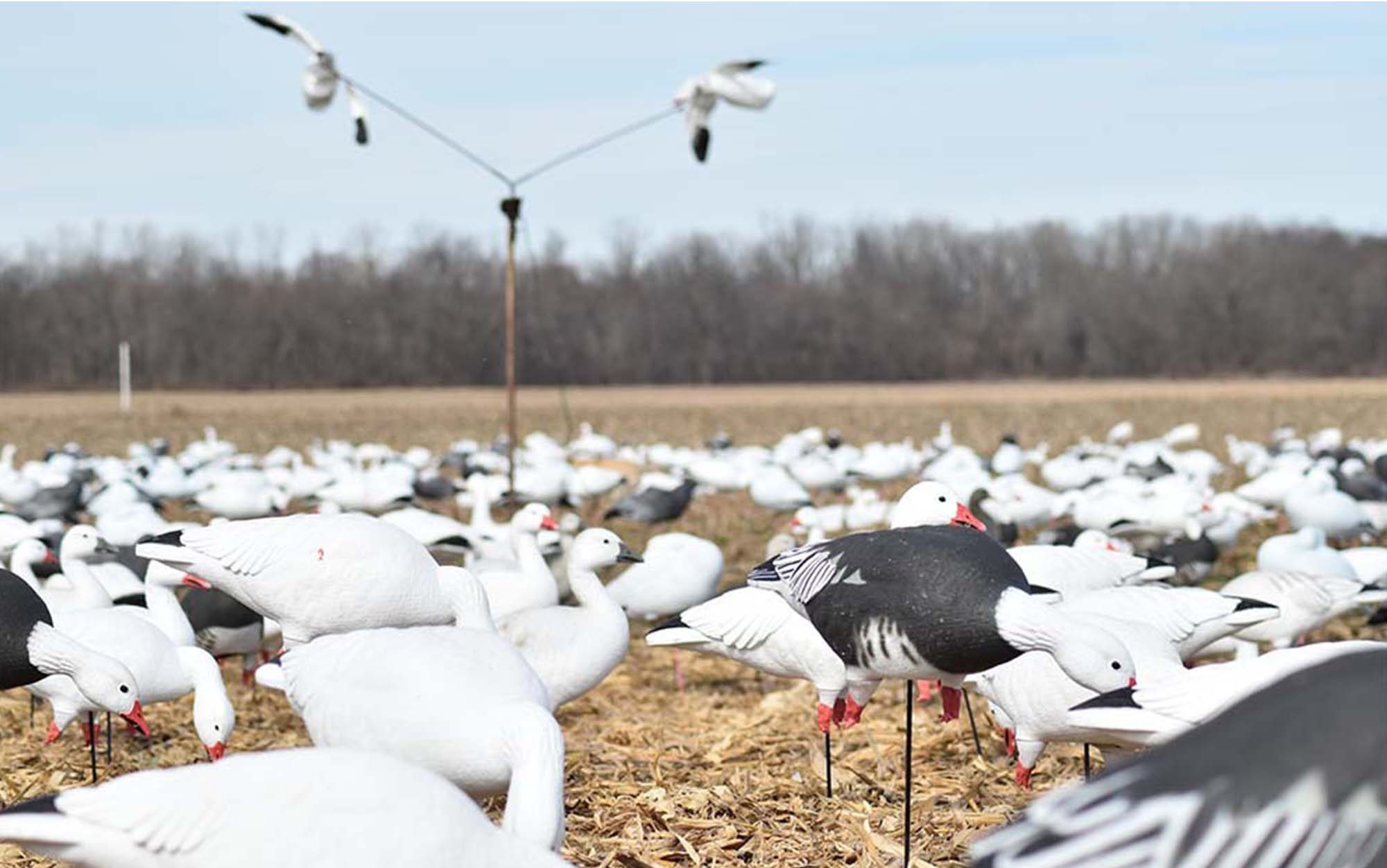
Buying Used
I know this is a story about the best new snow goose decoys, but just a cautionary tale if you buy used. If you are buying a large rig from someone, inspect the decoys. It’s likely some have cracks, paint rubbed off, broken bases or missing stakes. You don’t want to learn these facts post purchase. Be methodical in your inspection. Don’t just back up the trailer, hand over the cash, and start chucking full bodies.
Also, most hunters selling their decoys are doing so for a reason. Might as well ask them why. If they hesitate at all, it’s probably because the rig is junk and they are trying to recoup some of the money they spent. Be sure to compare the price of used decoys to new ones. I have seen some used decoy sellers ask for the same amount—or more—for the cost of new decoys.
FAQs
How many goose decoys you need depends on where you are hunting, the type of birds you’re targeting, and whether you’re hunting a feed or migrating geese. Typically when birds are on the move, and you are under a flight line, the more decoys, the better. It gets their attention and sparks curiosity. For that scenario, at least 700 to 1,500 decoys is a good start, and you can increase numbers up to 10,000 or more if you can afford it. Feeds don’t require as many decoys, because the geese are coming to that spot. Three hundred to 500 premium full-bodies can get the job done.
Socks and silhouettes cost around $5 to $7 per decoy. Full-body field decoys and floaters range from $20 to $35 per decoy.
Yes, No. 2s or 3s are ideal loads for snow geese. Snows are not hardy birds and so you should take pattern density over penetration or energy at the target, which is why 2s are a more ideal choice than 1s or BBs.
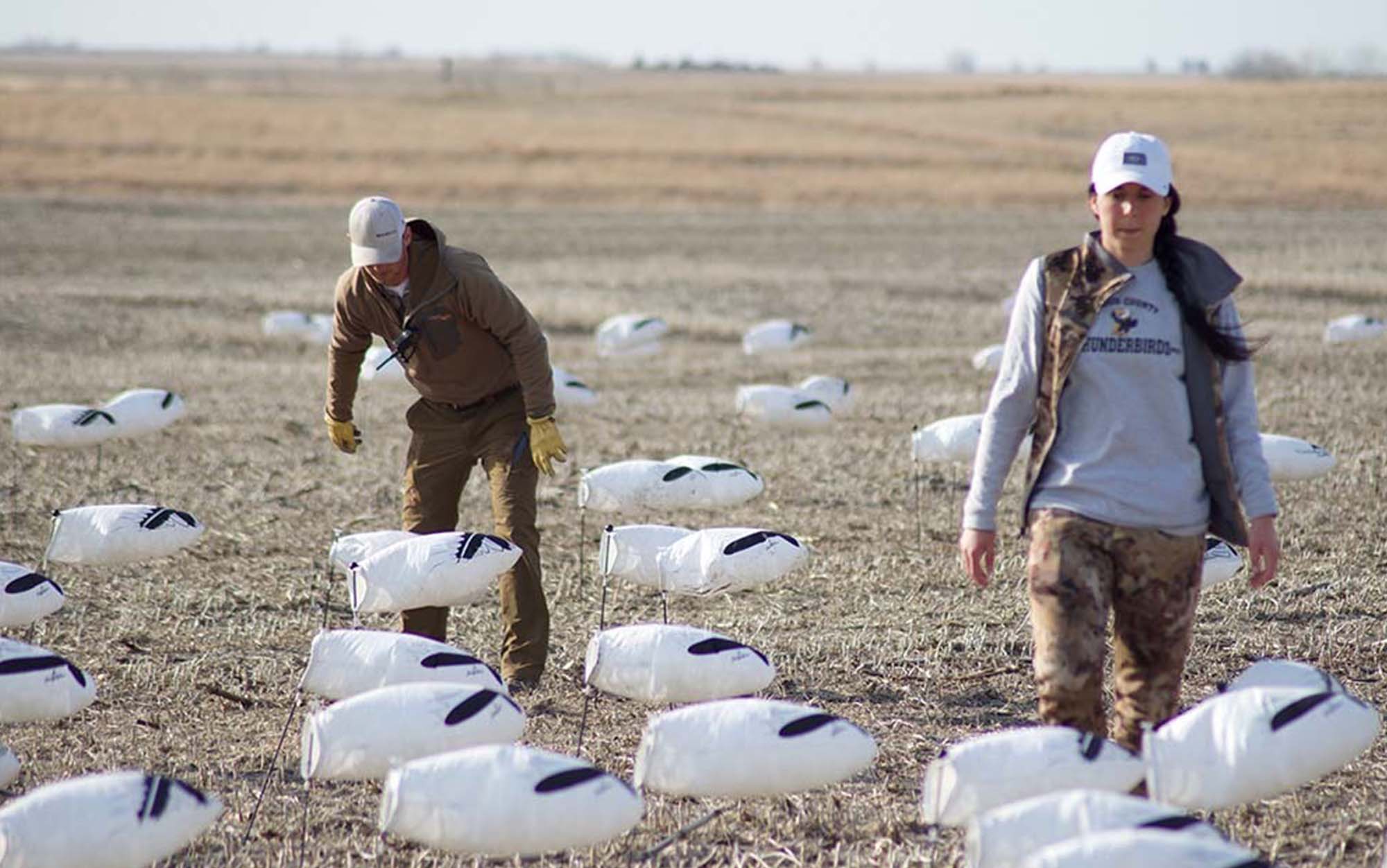
Final Thoughts
If you’re a dedicated snow goose hunter, that means you’re part of a small, but passionate fraternity. It also means you’re spending a lot of money, particularly on decoys. Remember to take your time and think about how and when you are going to be hunting before investing in a snow goose spread. That way, you will end up with a trailer full of the best snow goose decoys and, hopefully, have plenty of success tricking those big spins of snow geese into shotgun range.
